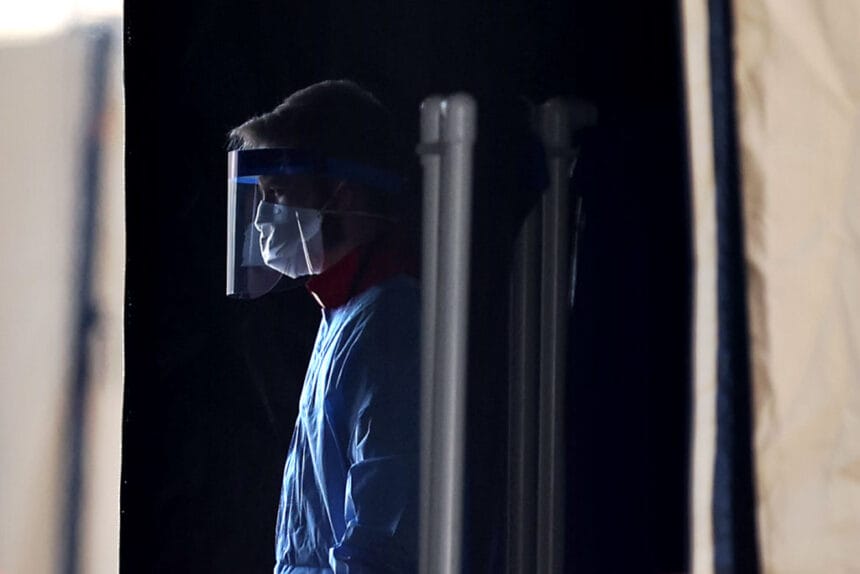This week marks the four-year anniversary of the start of the COVID-19 pandemic — a viral outbreak that killed nearly 1.2 million Americans and many millions more worldwide.
A virus that first appeared in late 2019 and festered slowly through the start of 2020 reached a fever pitch in mid-March.
As cases mounted, the World Health Organization declared COVID as a pandemic on March 11, 2020, with the Department of Health and Human Services following suit shortly thereafter.
From there, things developed quickly and life as we knew it changed forever.
The week that changed everything
That Wednesday night was one of the most surreal evenings in modern American history.
Then-President Trump gave a primetime speech in which he suspended travel from Europe for 30 days as cases ticked up. (A move he clarified the next day.)
Two-time Academy Award-winning actor Tom Hanks announced he and his wife Rita Wilson tested positive for COVID while in Australia for a film shoot.
Additionally, the National Basketball Association suspended its season in the midst of ongoing West Coast games.
What followed were nationwide lockdown measures and quarantines that lasted well into May.
Cultural touchstones like Broadway shows, the NCAA men’s basketball tournament commonly known as “March Madness” and the 2020 Summer Olympics in Tokyo were either postponed for months or canceled outright.
During the course of months-long lockdowns, people embraced the work-from-home lifestyle as much as they could — a phenomenon that resulted in a strained relationship between workers and employers to this day.
Additionally, medical misinformation ran rampant, with many criticizing the Trump administration for polarizing mask-wearing and social distancing measures while promoting questionable treatments and theories for COVID in the absence of vaccines.
On that topic, vaccines arrived in late 2020 thanks to the record development and testing by Moderna, Johnson & Johnson as well as Pfizer and BioNTech through Operation Warp Speed.
To keep business leaders across the marketing and advertising industries up-to-date on all of these fast-developing advancements and reliable information in a sea of misinformation, Haymarket Media launched its Coronavirus Brief, which evolved into the Vaccine Project Newsletter and lasted until early 2022.
Pandemic’s current status
We’re no longer in the emergency phase of the pandemic — both HHS and the WHO ended their respective declarations in May 2023 — but COVID is still around.
Though not near the record highs of hospitalizations and deaths set in early 2021, there were more than 15,000 COVID hospitalizations during the week between February 25 and March 2, accounting for 2.2% of all deaths, according to the Centers for Disease Control and Prevention.
While there have been additional vaccines approved to prevent serious infection and deaths, COVID booster shot uptake has trailed woefully behind public health officials’ expectations.
Some of this can be attributed to ‘COVID fatigue’ — a term that has taken hold in the cultural zeitgeist as people seek to embrace living in the vaunted ‘new normal’ rather than operating under a pandemic-era mindset.
Even the public health guidelines administered at the start of the pandemic have changed; with the CDC recently ending its 5-day isolation guidance for COVID-positive patients.
Simply put, the urgency that surrounded that week in March four years ago just isn’t there anymore.
Neither the White House nor HHS Secretary Xavier Becerra have issued a public statement or acknowledgement of the four-year anniversary of the outbreak, though some states and localities around the country have published their own remembrances.
Still, more people have the opportunities to share their individual stories going forward.
Earlier this year, the Library of Congress announced a collaboration with the nonprofit StoryCorps to compile oral histories of Americans’ pandemic experiences.
Where do we go from here?
There is still so much to unpack related to the impact of the COVID outbreak, from its effects on public health, the nature of long COVID in the body, the worsening of both the opioid epidemic and mental health crisis as well as the adverse effects on education.
As the dust continues to settle on several of these issues — as well as the origin of the virus in the first place — many industry stakeholders and public health officials seem to agree on one thing: this won’t be the last time.
COVID was a severe pandemic that disrupted the normal way of life for Americans — but it is unlikely to be the final one.
Maria Van Kerkhove, the interim director of the WHO’s Department of Epidemic and Pandemic Preparedness and Prevention, recently spoke withScientific American about the state of public health and the threat the COVID still poses.
That’s why a focus on pandemic preparedness and bolstering the nation’s public health infrastructure has taken on a heightened importance over the past four years, with many looking to a future where these problems are handled in a proactive manner.
Some like Rick Bright, the former director of the Biomedical Advanced Research and Development Authority, see the potential of AI in healthcare as a way to bolster global pandemic preparedness for outbreaks that are expected to arise down the line.
What the future holds for the next pandemic is anyone’s guess.
However, as the years go by and the memories of this immensely challenging time become further estranged from our day-to-day lives, it will remain to be seen what the lasting legacy of the pandemic is.








